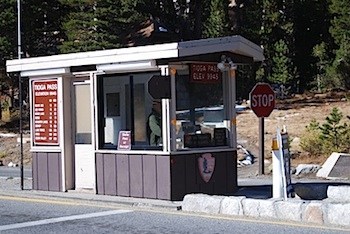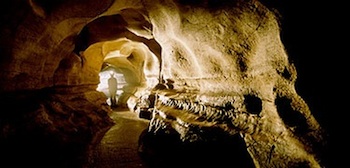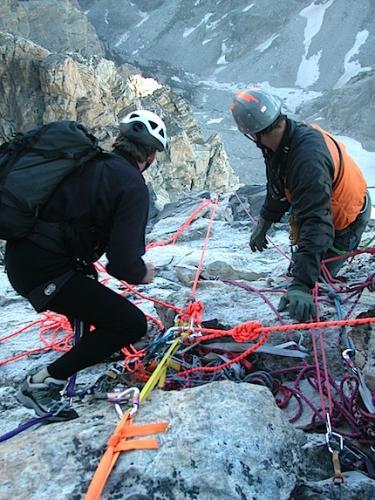Fewer rangers for search-and-rescue missions, closed campgrounds, and possibly more devastating forest fires are facing the National Park Service as a result of the looming budget fiasco, Interior Secretary Ken Salazar and National Park Service Director Jon Jarvis said Monday.
If Congress fails to avert the budget sequestration set to arrive Friday, the Park Service will delay plowing in snow-bound parks such as Yellowstone, Yosemite, and Glacier, seasonal hires will be delayed, leading to problems down the road, and some park facilities will be shuttered, the two said during a conference call with reporters.
"This department faces a perfect storm of impact, because we do so much in the summer months, which is so important to tourism here in this country," Secretary Salazar said. "So for us, when you’re looking at this level of cuts, it means impacts to visitors, our ability to fight fires, our ability to do the maintenance, and education, and support the hunting and fishing world which is so much a part of our economy.”
The phone call was just the latest step by Interior and Park Service officials to raise public concern over the opening and operational ability of national parks with the summer travel season just a few short months off.
In late January, Director Jarvis sent a memo out across the system that directed park officials to begin planning for layoffs and reductions in the hours of visitor centers. Then last week another, more detailed, memo of possible closures was released, and park superintendents were given permission to discuss how the sequestration would affect their specific parks.
On Monday the two officials reiterated those potential impacts.
“This will include reduced hours of operation for visitor centers, shorter seasons and closing of campgrounds, hiking trails, and other recreational areas when there is insufficient staff to ensure the protection of visitors, staff and the resources," said the Interior secretary.
Added Director Jarvis, "Great Smoky Mountains National Park will be closing five campgrounds and picnic areas, Blue Ridge Parkway will have to close seven contact stations, and Mammoth Cave will actually have to close a portion of the cave tours because we don’t have the staff to operate that. That could affect hundreds of thousands of visitors.”
To help cope with the cut, which comes atop $159 million in reduced federal funding the past three years, the Park Service already has delayed filling vacant permanent positions.
When a question was raised over how a 5 percent cut could lead to such extensive reductions in visitor services, Director Jarvis explained that, in reality, 85-90 percent of a park's budget is tied up in fixed costs, such as salaries and benefits and utilities, and so that 5 percent must come out of the remaining fraction. Too, he stressed, parks are being asked to exact 5 percent of their entire fiscal year over a period of six months.
"The last little bit of discretionary funding, which often runs arounds 10 percent, sometimes less in the smaller parks, is what you run your summer operation on. That’s your seasonal workfoce, that’s your little bit of discretionary budget that you can make decisions with each year," said the director. "And of course a lot of that varies on weather, how much snow you need to plow or whether you’ve got a lot of trees down in the campground to pick up at the beginning of the season.
"So 5 percent is really a significant hit on the discretionary part of a park’s operating budget. And so we have to figure out how to absorb it, and so it really comes into the front-line visitor services, which is really the thousands of seasonals that we hire every year.”

In something of a budgetary oxymoron, parks would be allowed to retain entrance fee revenues, but might not have the staff to operate the entrance stations. Kurt Repanshek photo.
To add to that perspective, a 5 percent decrease in the Park Service's budget reduces it to roughly $2.45 billion, which is about what the agency's budget was in 2008. Against that reduction, inflation has driven up the agency's costs in terms of fuel and utilities. And, since nearly six months of the fiscal year have passed, the agency has already obligated about 42 percent of its budget for full-time employee salaries, according to the Coalition of National Park Service Retirees.
With those figures in mind, it would take a cut of roughly 60 percent of the agency's seasonal hires, about 6,000 jobs, to achieve the 5 percent reduction this late in the fiscal year.
Though some might view the media event by Secretary Salazar and Director Jarvis as an effort to massage public opinion, their staff pointed out that national parks "are inspirational, provide respite from daily stress, encourage exercise and are just plain fun."
"They are also important drivers of our national economy, especially for the local communities near national parks," the staff added.
To buttress that last point, Secreteary Salazar and Director Jarvis noted both the economic might of the parks, and the impact that will be felt by gateway communities if the sequestration is implemented.
Visitation to the National Park System in 2011 visitors generated $30.1 billion in economic activity and supported 252,000 jobs nationwide, according to a peer-reviewed report released Monday by the National Park Service.
“Places like the Grand Canyon or the Statue of Liberty take our breath away and inspire us with their beauty and history, but our national parks also serve as anchors for our nation’s economy,” said Secretary Salazar. “People who visit parks need transportation, places to stay, and meals to eat – all of which support businesses and provide jobs in local communities.”
The statistics for 2011 are based on the spending of nearly 279 million national park visitors; more than one third of that total spending, or $13 billion, went directly into communities within 60 miles of a park. The numbers are on par with previous years, though last year the park system welcomed about 283 million visitors.
The sequestration would have an immediate economic impact on the gateway communities, said Director Jarvis.
“Yellowstone and Glacier will be delaying the plowing of the roads (by up to a month) to open those up, as much as a month, and that will have a direct impact in the gateway communities around Cody, or Jackson Hole or up in Glacier at White Fish," he said. "The communities there know that their season starts the day the road opens, and it closes the day the road closes. And that can be as much as $1 million a day lost to local economies.
“Grand Teton will be closing the Jenny Lake Visitor Center and the visitor center at the Rockefeller Preserve as well, impacting as many as 300,000 visitors this summer," he added.

Parts of Mammoth Cave might not have tours this summer due to staffing shortages. NPS photo.
At Yosemite, plowing of the Tioga Road through the park's high country will be delayed, affecting tourism on the eastern side of the park in towns such as Bishop, Mammoth and Lee Vining.
At Mount Rainier National Park, the Ohanapecosh Visitor Center would be closed this year.
“I am concerned about the impact to visitor safety, because there will be a reduction in the number of our rangers in the field this year as a result of these impacts," added the Park Service director. "As we gear up for summer, we hire a lot of summer seasonals, many of them are returning seasonals that have extraordinary skills in fire-fighting, and search-and-rescue, and river running and high-angle work, and if we are not able to hire that seasonal workforce, then clearly our capacity to respond to emergencies will be reduced.
“As a consequence we may be reducing access to some areas because of that concern."
But all these impacts don't need to occur, said the Interior secretary.
“This is certainly an avoidable consequence that just requires the members of Congress to do the right thing," he said.




Comments
So the Burce, Kathy, Johnny and Diane, that don't have guaranteed salaries, automatic raises, tenure, union protection, guaranteed pensions don't work? Do they not get their hands dirty or even die on the job? These folks have taken substantial pay cuts over the last several years or even lost their jobs. Has that been matched in the public sector? No.
You may want to call it rhetoric, but it is fact.
But then to get back to my point which you keep twisting into an attack on the NPS - which it is not. This is all chicken-litte fear mongering to protect Obama's (and the progressive's) socialist programs. There are plenty of places that money could be cut without impacting the Parks or the NPS. Obama and his minions don't want to make those cuts so they threaten your Parks, teachers, firemen etc because that is what will get the most public reaction. As Mike says - we can't keep spending the way we are.
MikeG, while a president can propose cuts through his budget, Congress has to enact them. The following story shows hundreds of millions of dollars in cuts proposed by the Obama administration, including some controversial with the environmental communities.
http://www.thestreet.com/story/11798889/1/here-are-the-budget-cuts-presi...
And look how Congress padded out the supplemental appropriations bill for cleaning up the aftermath of Hurricane Sandy:
http://www.taxpayer.net/library/article/brief-analysis-of-selected-provi...
This is not a defense of President Obama. Rather, just an attempt to show the current fiscal fiasco is not one man's/politican's doing.
Kurt,An interesting list but did you add up the total savings? $1.137 billion. A drop in the bucket. Heck, O's State of the Union proposals would cost $84 Billion to implement.
Our deficit is $1.1 TRILLION. If we are going to cut the deficit we need to be cutting programs that are costing Billions not just those costing millions. For example, extending unemployment benefits cost $30 billion directly and by encouraging people not to work (and therefore not pay taxes) cost even more. Those are the kinds of programs that need the ax (in addition to the smaller ones on Obama's list)
Life is about choices. We can only spend so much for so long. You can have your social programs or you can have your parks. You can't have it all. I would prefer the parks and am offended at Obama holding them hostage.
Yes it will take Congressional action, but if Obama would make those proposals and push them as hard as he has pushed his socialist agenda, Reid and Pelosi would have to go along and the Republicans (as a whole) certainly wouldn't stand in his way.
I agree Kurt. It is not solely the responsibility of the President. There is much blame here, for all involved. My point is that our President is our leader. He should be establishing a direction here for the nation not nibbling around the edges with some (very minor) spending reduction proposals.
The Congress has no budget. Four years running now I think. How in heaven's name do you make meaningful decisions in the absence of this tool? Why hasn't the president insisted that a budget be established by Congress? Please don't bring up the Presiden't own proposal last year that got exactly 0 supportive votes in the U.S. Senate.
Deficits have exceeded one trillion dollars each of the past four years. "But he had to save the economy!" his supporters scream. "Undeclared wars!" others scream. Meanwhile, again this year we will spend over one trillion dollars more than we have.There is always an excuse for a politician and for a partisan. Meanwhile, the country is drowning.
Y'all know the defintion of modern American socialism, don't you?
Socialize expenses; Privatize profits.
Privatize profits has always been there - as it should be. Its the socialize expenses which is the "modern" component.
Privatize profits is just fine -- but not when taxpayers are footing the bill as we so often seem to do.
By the way, I just finished my income tax for this year. Had to chuckle because I -- retired, living on a rather modest, but reasonably comfortable retirement income, working a little bit part time -- have an effective tax rate that is almost three points higher than the one Mitt Romney said he had. Now, does anyone want to talk about sucking at the public teet (sic)?
Billion-dollar+ savings?
What about farm subsidies ($194 billion since 1995 and another $34 billion to crop insurance companies)? What about oil industry subsidies (an estimated $10 billion-$52 billion annually)?
Should taxpayers be subsidizing companies that sell their products to the highest bidder, no matter where in the world they might be?
This is not to say government programs don't need better accounting and auditing (and spending decisions). Rather, it's with hope that sanity does return to Washington.